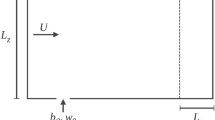Summary
When the rising plume in a stagnant ambient fluid impinges the free surface it spreads radially as a surface layer flowing over a pool of heavier liquid. Initially the surface layer in the “entrainment zone” entrains the underlying fluid, but the entrainment decreases with the increasing distance from the “boil”. The radius of the entrainment zone depends on the initial buoyancy flux from the nozzle and also on submergence height. It was assumed that the flow in this zone has a self-preserving form. The theoretical results based upon this assumption showed that the maximum velocity and density difference of the layer decreases as powers of radius distance measured from centre of the boil and the depth varies linearly with the radius, so that the sectional Richardon's number based on maximum physical quantities of the section remain unchanged. It was further shown that the coefficient of the entrainment remains constant and is a function of the Richardson's number and the slope of the interface. The theoretical results were compared with those obtained experimentally and fair agreement was obtained.
At the end of the entrainment zone the surface layer enters the “zone of homogeneous flow” in which the layer travels over the underlying fluid and behaves much like a free homogeneous flow over a rigid boundary: the friction at the interface replacing the friction of the boundary. In this zone the mean velocity of the layer in the radial direction was measured and found that it decreases inversely with the increase of radius. The thickness of the layer in the zone of homogeneous flow remains constant and depends, as far as experiments show, greatly on the submergence height.
Similar content being viewed by others
References
A. M. Rawn and H. K. Palmer, Pre-determining the extent of a sewage fluid in sea water,Transactions, A.S.C.E., 94 (1930) 1036–1060.
W. E. Hart, Jet discharge into a fluid with a density gradient,Proc. A.S.C.E., 87, No. HY6, (1961) 171–200.
J. J. Sharp, Spread of buoyant jet at the free surface,Proc. A.S.C.E., 95, No. HY3, (1969) 811–835.
G. K. Batchelor, The conditions for dynamical similarity of motion of a frictionless perfect-gas atmosphere,Quart. J. Royal Met. Soc., 79 (1953) 224–235.
J. O. Hinze,Turbulence, McGraw-Hill Book Comp. Inc. (1959).
A. A. Townsend,The structure of turbulent shear flow, Cambridge University Press (1956).
T. H. Ellison and J. S. Turner, Turbulent entrainment in stratified flows,J. Fluid Mech., 6 (1959) 423–448.
H. Rouse, C. S. Yih and H. W. Humphreys, Gravitational convection from a boundary source,Tellus 4 (1952) 201–210.
H. Rouse, ed.,Advanced Mech. of Fluids, London, Chapman and Hall, (1959).
D. G. Fox,Turbulent gravitational convection in a stratified fluid, Ph.D. Thesis Princeton University, (University Microfilms, Ann Arbor) (1968).
Author information
Authors and Affiliations
Rights and permissions
About this article
Cite this article
Anwar, H.O. The radial spreading as a free surface layer of a vertical buoyant jet. J Eng Math 6, 257–272 (1972). https://doi.org/10.1007/BF01535186
Received:
Issue Date:
DOI: https://doi.org/10.1007/BF01535186



